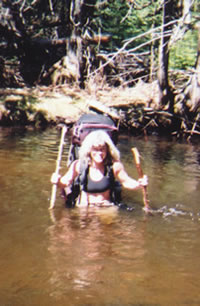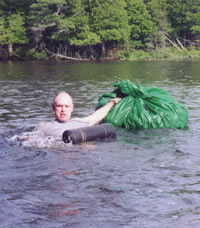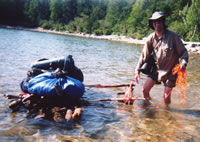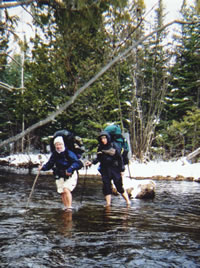Have you ever arrived a remote spot
along a river and wondered what lay beyond the opposite bank?
Maybe a secluded ridge dotted with old growth. Perhaps a hidden
cave.
Have you wondered what it would be
like to bivouac on island just offshore? Or, has a steep cliff
ever stopped you cold on a remote shoreline?
If the lure of the less-traveled
side of a waterway has you hooked, it may be time to cross
over and check it out.
Crossing rivers and waterways, especially
those with cold, deep water or swiftly flowing current, can
be very challenging and dangerous for even the most experienced
wilderness tripper. In "The Backpacker's Field Manual,"
author Rick Curtis notes, "More backpackers are killed
in stream crossings than die from snakebites." Be careful
and err on the side of caution. Always wear a personal floatation
device.
In selecting a spot to cross a river, look
for a slow-flowing, obstruction-free section. Wide, relatively
straight sections are generally shallower and less swift than
narrow areas and sharp bends. Check the opposite bank to make
sure it will be easy to clamber up.
To learn more about the character of a
river's current, like where you might end up if you loose
your balance and get swept away, toss a stick into the river
and watch where the current takes it. Rocks can be thrown
into the current to help differentiate between shallow and
deep areas.
Avoid wading across swift-water areas that
reach above your knee, as foot entrapment and subsequent drowning
is a real hazard in strong current. Likewise, never attempt
crossing a river in flood stage or that's strewn with logs,
slabs of ice, and other floating debris.
If there is any doubt about your ability
to safely negotiate a crossing in the location at-hand, don't
try it. Instead, thoroughly scout upstream and downstream
for a manmade bridge, natural bridge, or a safer fording area.
Study a topographic map for a more promising spot. Look for
placid, meandering sections where the contour lines are spread
out, indicating a low gradient. Places where the river spreads
or divides into several smaller, less challenging channels
are also good areas to look for.
Once a suitable area is found, check for
hazards downstream from the crossing point in case you get
into trouble. Avoid crossing just upstream of
- bends in the river
- waterfalls
- dams
- violent rapids
- log jams
- sweepers (overhanging trees)
- strainers (submerged logs, exposed
roots, brush, and vegetation)
- cliffs
- undercut banks
- dangerous hydraulics (boiling souseholes
or recirculating current holes that hold onto swimmers,
sometimes underwater)
- fences (across the river)
- old bridge pilings
- standing waves (unlike lake waves that
move, standing river waves or haystacks don't move and indicate
deep water)
It's also a good idea to locate secondary
landing areas as well as points where spotters can stand by
with ropes or long poles in case a rescue is necessary. Calm
pools of water and long, shallow stretches make good wash-out
areas.
Loose or baggy clothing--especially bloused
pants and tucked-in shirts--trap w water, create a lot of
resistance, and are very difficult to swim in. Cross in shorts
or a tight-fitting layer of polypro underwear. Whatever you
end up wearing, opt for quick-drying synthetic layers over
deadly cotton ones.
Always wear some form of footwear for ankle
support, traction, and to protect your feet from underwater
debris such as sharp sticks, fishhooks, broken glass, pieces
of metal, barbed wire, etc. Tennis shoes, Nike Aqua Socks,
and strapped sport sandals work well.
When you reach the opposite bank, be prepared
to dry off, change into dry clothing, consume some snacks,
and start moving as soon as possible to warm up. A lightweight,
but highly absorbent "pack towel" is handy for drying
off.
Unless you're wearing a personal floatation
device (PFD), swim well, and are knowledgeable about swift-water
safety, don't attempt to cross anything but the calmest and
shallowest of creeks.
Hypothermia, caused by exposure to cold
water and/or air temperatures, is a hazard of river fording.
Learn to avoid, recognize, and treat it. It's early warning
signs include:
- slurred speech
- confused thinking
- shivering, fatigue
- poor coordination
A couple of walking sticks or a long pole
can be used on the upstream side to create a stable, three-
or four-point stance when crossing. Equally weight both feet
and the supports, moving only one contact point at a time
for maximum stability. 
Jane Beckwith of East Lansing
uses two improvised walking sticks
to ford the Pigeon River
on an early May '02
CUP Group trip.
(Photo by Mary Powell)
To use a balance pole, rest one end of
the pole against your shoulder and angle the business end
out into the current. To maintain control of the pole, grasp
it with one hand placed up high, near your shoulder, and the
other hand down low, near the water. This same pole is also
very handy for probing the river bottom for hidden hazards
such as
- logs
- exposed roots
- rocks
- quick-sand-like areas (also known as
loon shit)
- drop-offs
By facing upstream, or at least up-current,
you'll be able to read the current as well as prevent the
force of the water from buckling your legs at the knees. Movement
should be slow, deliberate, and methodical, like a crab. Check
your footing as you go and walk with a wide, flat gait as
you lean into the current.
Always force your legs through the water
in short shuffle-like steps instead of lifting them up and
out of the river each time. Sliding or scooting your feet
along will reduce the chance of foot entrapment. It'll also
prevent shifting current forces from upsetting you each time
you move a foot in and out of the current.
Generally, it's best to cross at a slight
angle to the current, either up-current or down-current. Crossing
current at a right angle is not recommended for maximum stability.
Whatever you do, keep moving while in the current to maximize
your balance and control.
On longer fords, look for places to rest,
such as the slack water or "eddies" located on the
downstream side of boulders. Mid-stream gravel bars, sandbars,
and islands work well too.
A partner or two can make river fording
easier since the lead or upstream person breaks the current
while the others provide support. Groups can form into a number
of secure and stable formations. A straight line or "chain"
formation is very common. Other huddle-like formations include
the triangle, circle, and wedge.
Group formations can be strengthened if
the members lock arms, clasp hands, or grasp onto each other's
clothing or backpack. Having everyone grasp a very long pole
at chest level is another option. Whether a group forms up
side-by-side or facing each other, the force of the current
can be minimized if the formation stays parallel to current,
not perpendicular to it.
Sometimes it's safest to simply get your
feet wet and wade across a river instead of trying to stay
high and dry on a slippery log or a series of unstable, slimy
rocks. If you elect to cross on logs or rocks, a walking stick
can reduce the chance of a slip and fall. A handful of fine
gravel or sand can be spinkled on a slippery surface too.
Depending on the load, a properly waterproofed
rucksack may float very well. Double bag critical gear with
large, heavy-duty plastic bags, twisted and knotted shut.
For deepwater, swimming-type crossings, you can improve the
buoyancy and waterproofness of a rucksack by securing a plastic
or nylon tarp around it.
If you're going to wear a rucksack during
a crossing, always loosen the shoulder straps and undo the
waist belt and sternum straps so you can jettison it quickly
if you get into trouble. Avoid carrying anything in your hands,
other than a walking stick, as you'll need to be able to swing
your arms to maintain or regain your balance.
If you get into trouble and end up swimming,
immediately jettison your rucksack and use it for floatation
while working your way to shore.
In rocky rapids, float on your back with
your feet pointed downstream and near the surface so you can
both avoid foot entrapment and fend off rocks. If you're bearing
down on a logjam or strainer, reverse your position in the
water and approach it hands-first, on your stomach, so you
can immediately clamber up on top of the deadly mess. You
must act quickly to prevent the current from entrapping you
beneath the deadly sieve.
In certain situations, a rope can be rigged
from bank to bank as taut hand-line or "rail." To
reduce the chance of entanglement, use floating rope and always
work your way across the river along the downstream side of
the line. Never, ever, tie a rope to yourself as the force
of the current will hold you underwater and drown you in certain
situations if you loose your footing.
If you're an experienced swimmer wearing
a PFD, swimming with a floating rucksack in tow or in front
of you may allow you to cross waterways that are too deep
for traditional fording. Not only will this technique get
you across deep-water rivers or out of river fords gone bad,
it'll also allow you to reach isolated islands and cross narrows
in lakes. 
Michael Neiger
swims a lake narrows
on Drummond Island's
Pine Lake during a July '02
CUPG trip.
His rucksack is waterproofed
with a silicone nylon tarp
and he's improvised a PFD
from his closed-cell
foam sleeping pad.
(Photo by Rick Szumski)
A good way to make a rucksack more waterproof
and buoyant--after double-bagging critical contents such as
food, sleeping bag, and clothing in heavy-duty plastic bags--is
to lay the rucksack on a nylon tarp or piece of clear plastic.
Next, wrap the material up around the rucksack, gathering
and tightly twisting the surplus edge material together, before
securing it with a piece of rope.
Another alternative is to construct a raft
by lashing logs together. It keeps the packs out of the water
and affords swimmers a place to rest, rehydrate, and snack
during longer crossings.
Michael Neiger,
Mary Powell of Flint (not shown),
and Sue Schenk-Drobny
of Marquette (not shown)
used this raft constructed of
dried beaver timbers lashed
together to get around a
1300-meter-long section of
trailless, rocky, Lake
Superior shoreline in Canada
on an Aug '02 CUPG trip.
Note use of outrigger to stabilize raft.
(Photo by Mary Powell)
Since the rucksack loads vary, experiment
with your floating pack system before a trip to make sure
it floats properly. If the danger of entanglement is not an
issue in flat-water situations, a short tether can be used
to maintain control of a floating rucksack.
A stream, lake narrows, or other waterway
without a manmade bridge does not have to be the end of your
journey. In fact, it could be the start of a whole new one.
By learning when and how to safely ford or swim a wilderness
waterway, you may be able to reach some less-traveled backcountry.
Return
to top of page | Return
to home page
In
God's wilderness lies the hope of the world,
the
great, fresh, unblighted, unredeemed wilderness.
—
John Muir 1838-1914, Alaska Wilderness, 1890
Content
Copyright © by Michael A. Neiger
All rights
reserved.
Comments?
Suggestions? Dead links? Inaccurate info?
Contact the
WebMaster at mneiger@hotmail.com
A
MacroMedia DreamWeaver 4 and Fireworks 4 production
|





